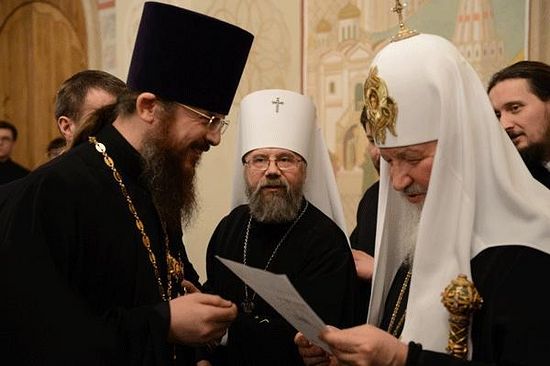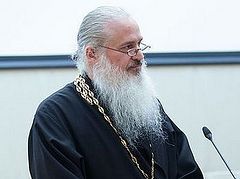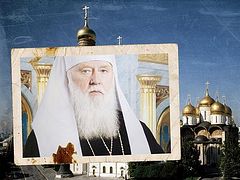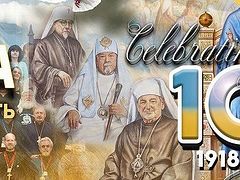Introduction by Matfey Shaheen:
 Archpriest Rostislav Yarema. Photo: sv-troitsa.ru We are very happy to present to you an article by the famous Ukrainian Archpriest and Professor Rostislav Yarema. Father Rostislav is a Doctor of Theology and one of the most qualified experts in the Moscow Patriarchate on matters relating to Orthodox history in Western Ukraine and as well as Poland.
Archpriest Rostislav Yarema. Photo: sv-troitsa.ru We are very happy to present to you an article by the famous Ukrainian Archpriest and Professor Rostislav Yarema. Father Rostislav is a Doctor of Theology and one of the most qualified experts in the Moscow Patriarchate on matters relating to Orthodox history in Western Ukraine and as well as Poland.
Father Rostislav is a priest from the lands of Lviv (Lvov), a region of Galicia, from that same fair Western Ukraine, which is very dear to the Church of Rus’. Many great church figures, new martyrs, and confessors have shone forth in those lands such as Saint Job of Pochaev, Saint Petro Mohyla1, Saint Alexis the Carpatho-Russian, and many others. Western Ukraine is also the birthplace of His Beatitude Metropolitan Onuphry of Kiev and All Ukraine.
Unfortunately, Western Ukraine is also one of the most long-suffering regions in Eastern Europe, when at times the rivers Danube, Dniester, Tisa, Vistula, Prut, and Buh practically ran red with martyrs’ blood, and the hills of Galicia-Volhynian and mighty Carpathian Mountains became like a second Golgotha.
Why do I say this? Because Father Rostislav does not simply possess academic knowledge of these areas, he was born there, it’s his motherland. It is very important to hear about the Ukrainian Church Crisis from Ukrainians born and raised there.
Father Rostislav is also a giant in the academic and theological world as well, having great authority in matters of Orthodox history in Ukraine, as well as Poland and Russia. He graduated from the Moscow Theological Academy at the Holy-Trinity-Sergius Trinity Lavra in 2010, with the level Candidate of Theology (similar to a Ph.D.). He then completed his doctoral degree at the Christian Theological Academy in Warsaw, Poland, and was awarded with the title of professor.
The author of many publications in Ukrainian, Russian, and Polish, Father Rostislav is the laureate of 33 Church awards, including a memorial cross presented by the Primate of the Polish Orthodox Church, the Orders of Equal-to-the-Apostles Mary Magdalene, Cyril and Methodius, and Rostislav of Great Moravia (3 separate awards), as well as an Award for Excellence from the Primate of the Ukrainian Orthodox Church and the Diocese of Mukachevo, the Order of Saint Andrew the First Called, the Order of the Venerable Anthony and Theodosius of the Kiev Caves, the Order of Prince Vladimir, and the Order of Saint Petro Mohyla.2
Father Rostislav is also the Editor of the website “Patriarch of All Rus’”, a project he created with the personal blessing of His Holiness Patriarch Kirill of Moscow and All Rus’3. The website serves to inform believers of the archpastoral work of His Holiness and is published in Russian and Ukrainian, demonstrating the unity of the Church of Rus’. We thank Father Rostislav for giving his blessing to share his article translated for his website, as this is a rare opportunity for English speakers to receive direct academic information concerning issues of the Ukrainian church.
This article presents a timeline of schism in Ukraine. There is nothing like it available in English, partly because the history is so complicated and convoluted.
 His Holiness Patriarch Kirill of Moscow and All Rus’ with Archpriest Rostislav Yarema (left). Photo: patriarch.ua
His Holiness Patriarch Kirill of Moscow and All Rus’ with Archpriest Rostislav Yarema (left). Photo: patriarch.ua
This organizational overview of the church schisms in Ukraine I compiled was produced to reflect on the situation with the schismatic movements in Ukraine in the style of a “tree of schisms”4 which is known to us. The essential difference of this experience is that in truth we have here an image not of the Church of Christ, but actually divisive tumors, which like cancer metastases are with a rapid force affecting Ukrainian society, parasitically feeding on the body of the state, and corrupting the minds and hearts of its spiritually weak and emotionally unstable adherents.
The first thing I want to draw your attention to is that every schismatic leader who was before in communion with the church and was a priest or a bishop, had so-called “canonical immunity”. The 25th Apostolic canon says:
If a bishop, presbyter, or deacon be found guilty of fornication, perjury, or theft, let him be deposed, but let him not be excommunicated; for the Scripture says, "you shall not punish a man twice for the same offense." In like manner the other clergy shall be subject to the same proceeding.5
According to this principle, there is a system of restraints and warnings for a cleric who has gone astray. And you need to have a stubborn and conscious will to oppose the Church and go into a schism. The tragedy of the situation is usually aggravated by the fact that a schismatic priest carries away his whole flock or some part of it along with him. The schismatic bishop can take with him priests, the metropolitan or bishop. But we do not know of a single case where, bishop would follow a priest and also go into schism. This explains the hierarchical principle of the Church, based on the Holy Scriptures: “And without all contradiction the less is blessed of the better.” (Heb. 7:7)
The overview is based on the subject-chronological principle; the Ukrainian Orthodox Church, which is part of the Moscow Patriarchate, has existed without interruption from well before this chronology of schism. Therefore, Ukraine is the canonical territory of the Moscow Patriarchate. All Local Orthodox Churches recognize and respect this principle, according to which there cannot be two archpastors of one city. Recently some theologians have tried to refute this principle and call it an ecclesiological heresy.
In this case, the 8th Canon of the First Ecumenical Council says:
“For it is not right that in the same city there should be two bishops…”6
The Bishop of Rome Cornelius (251-253) teaches:
“When in a certain place a Bishop is installed, and his instillation is recognized by all other bishops and the people, then under no circumstances should another bishop be installed on this place.”
The authoritative canonist Bishop Nicodemus (Milash) (†1956) in an interpretation of the 8th Canon of the First Ecumenical Council clarifies:
“It can be quite easy that the case with Novatian in Rome gave the Nicene Fathers a reason to publish the cannon on the Novatianists, remembering in this way that this law basically stipulates that in one place (and according to our present canonical terminology, in the territory of one diocese) there can only be one bishop with real, proper episcopal jurisdiction and not two.”
Therefore the only legal, canonical, and grace-filled Church in Ukraine can be considered to be the Ukrainian Orthodox Church, from 2014 to the present headed by His Beatitude, the Metropolitan of Kiev and All Ukraine Onuphry (Berezovsky). From 1992 to 2014, the Primate of the UOC was His Beatitude Metropolitan Volodymyr of Kiev and All Ukraine (Sabodan).
Every schism, like every crime, has its motives. An ancient Roman aphorism reads: In fecit, qui prodest—for whom the crime advances, he has done it (from Latin). Who else besides the enemy of mankind benefits from schism?
What are the schismatic leader’s goals? It [schism] can be beneficial both directly to the founder of the schism (for example, Philaret [Denisenko]), and to the whole schismatic group (for example, to the self-consecrators). Suppose there existed some theological problem or another, on the basis of which a specific historical figure can use his potential or power, knowledge, and personal authority, and draw some or all of his followers into the fold of such a schismatic denomination, in which this problem would be resolved.
Thus have many schismatic movements risen and fallen, having nothing in common with the Orthodox Church, ignoring soteriology7 and canon law.
Schismatic denominations separated from the UOC are indicated by the year of the schism, and the name of its founder. Each schism also has both a legal name registered in the Ministry of Justice (for example, the UAOC and the UOC-KP) and a popular name (for example: “self-consecrators”, “Polycarpites” “Philaretists”, “Anathemites”)
Here is brief information on the schisms shown in this overview:
-
The Autocephalist schism of the first generation—the Lipkovsky-Self-Consecrators
Founder: self-consecrated “Metropolitan” Vasily Lipkovsky, former Archpriest; October 14–30, 1921, the schismatic constituent assembly is held under the auspices of the “All-Ukrainian Orthodox Church Council.”8
Characteristically: Abolished the canons of the Orthodox Church and issued their own cannons. Proclaimed non-obligatory monasticism for bishops, sought for “nationwide independence”
In 1930, the UAOC self-liquidated as quickly as it had been previously organized.
-
Autocephalist schism of the second generation—the Polycarpites
Founder: “Archbishop” Polikarp (Sikorskyi) former bishop of Lutsk; January 24, 1942, in German-occupied Ukraine, the Reichskommissariat registered a new generation of the UAOC.
Characteristically: Served and assisted the occupying regime, “consecrated to the episcopacy” Mstyslav (Skrypnyk)
In January of 1944, together with the fascists the schismatics left Ukraine, some of them scattered across different continents, and the other part ended the schism, joining the Patriarchate of Constantinople or ROCOR.
-
Autocephalist schism of the third generation—Ioann (Bodnarchuk), Neo-Lipkovsky.
Founder: Bishop Ioann (Bodnarchuk), unremarkable.
October 22, 1989, Bishop Ioann (Bodnarchuk) violated the ecclesiastical jurisdiction of Archbishop of Lviv Irenei (Seredniy), and performed a Liturgy and proclaimed himself the “First Hierarch” of the UAOC.
Characteristically: Ioann (Bodnarchuk) conceded the leadership to “Metropolitan” Mstyslav (Skrypnyk), and he himself asked the Synod of the Russian Orthodox Church for dismissal. He spread its influence abroad, an dblessed the creation of the Russian Orthodox Autonomous Church. On June 5–6, 1990, at the “First All Ukrainian Council of the UAOC” Mstyslav (Skrypnyk) became “patriarch” and Ioann (Bodnarchuk) became “Metropolitan” and Locum Tenens. The UAOC transformed into a so-called “Kievan Patriarchate”.
On October 14, 1993, the part of the UAOC that was not united with Philaret, after the death of Mstislav (Skrypnik), elevated the archpriest who fell into schism Volodymyr [Dymytriy in “monastic tonsure”] Yarema to “patriarch”.
At that same time, the UAOC in the diaspora becomes congregational, not recognizing any of the “patriarchs”: neither Vladimir (Romanyuk) (1993–1995) nor Dymytriy (Yarema) (1993–2000).
In 1995, the hierarchs Constantine (Bagan) and Anthony (Scherba) emerged from this split, establishing a UOC in the bosom of the Patriarchate of Constantinople.
On June 5, 1995, the registration of the UAOC Charter was restored, which meant the re-legalization of the UAOC as a religious organization (the first time was on October 2, 1990).
-
In 1996. as a result of the spontaneous “Council of Bishops” of the UAOC, the Synodal UAOC was formed, which rejected the “patriarch” Dymytriy (Yarema), and existed for exactly for exactly one year.
14–15 September 2000. The successor of the late Patriarch Dymytriy (Yarema) was Metropolitan Methodius (Kudryakov) (2000–2015), and after Metropolitan Methodius (Kudryakov), Metropolitan Makariy (Maletich) (2015-2018).
-
In 2001, the hierarchy of “Metropolitan” Michael (Dutkevich) († 2001) is separated from the UAOC († 2001), establishing the “Apostolic Church”. Since 2002, the “primate” of this schism of the UAOC has been the “archbishop” of Luke (Narolsky) (2002–2014); and now the “Metropolitan of Kiev and All Ukraine” Stephen (Negrebetsky) (from 2014 to the present).
-
In 2002, from the UAOC-S in the USA, the UAOC-S is established in Ukraine, headed by “Metropolitan” Moses (Kulik).
On June 18, 2005, Moses (Kulik) becomes the “patriarch”, and from the UAOC-“Soborno-pravnaya” (Catholic/Council based), is formed in Ukraine the “UAOC-canonical”.
-
In 2003, a hierarchy headed by “Archbishop” Igor (Isichenko) is separated from the UAOC. Since 2006, this schismatic group with its center in Kharkov is called UAOC (renovated).
-
The Philaret Schism—the foundation of the Ukrainian Orthodox Church of the Kievan Patriarchate
Founder: former Metropolitan of Kiev and All Ukraine and primate of the Ukrainian Orthodox Church of the Moscow Patriarchate Philaret Denisenko.
On May 27,1992, the Bishops’ Council of the UOC on behalf of the Synod of the ROC deprived Metropolitan Philaret (Denisenko) of his position as primate and banned him from serving, and elected the new Primate of the UOC Metropolitan Volodymyr (Sabodan). Metropolitan Philaret’s (Denisenko’s) disobedience to the Bishops’ Council of the UOC in Kharkov is considered to be the beginning of the Philaret schism.
Characteristically: For the first time, a split is created by a figure clothed with such dignity and authority, dragging two full-time bishops into the split: Jacob (Panchuk) and later Andrew (Gorak).
June 11, 1992. The Bishops Council of the Russian Orthodox Church deposes Philaret from his episcopal and priestly dignities, officially lowering him to the status of a simple monk.
On June 25–26,1992, the “unifying council of the two churches” announced the creation of the “Ukrainian Orthodox Church, Kiev Patriarchate” from the part of the UAOC Mstislav (Skrypnik) and the followers of Philaret (Denisenko). Mstislav (Skrypnik) himself learned about the incident from the evening news. “Metropolitan” Philaret and “Bishop” Jacob “ordained” the autocephalist self-concecrators as “bishops”.
October 21, 1993 Vladimir (Romanyuk) († 07/14/1995) becomes the “patriarch” of the UOC-KP, with the real power in the hands of the power- hungry Philaret (Denisenko), who hold the the rank of “deputy”.
March 20, 1994. “Patriarch” Vladimir (Romanyuk) accepted with autonomous rights the schismatic group of the former Catholic priest, now “Metropolitan” of Milan Eulogius (Klaus Hessler).
October 22, 1995 Philaret becomes Patriarch of the UOC-KP.
February 18–23, 1997. The Bishops Council of the Russian Orthodox Church deprives M.A. Denisenko [Philaret] of monasticism, excommunicates, and anathematizes him.
-
In 1996 having quarreled with Dymytriy (Yarema), and in 1997 not wanting to be behind the staff of Philaret (Denisenko), “Metropolitan” Peter (Petrus) founded in 1999 the “Autonomous Orthodox Community of St. John the Theologian in Lviv”. He does not posses a church nor is he in submission to anyone.
March 15, 2000. The Synod of the UOC-KP establishes a special “tomos” with the Greek Exarchate, headed by Timothy (Kutalyos) († 2004), the “bishop” of Korsun (now called “Metropolitan” Chrysost [Bakomitros]). Philaret (Denisenko) does not recognize the deprivation of his dignity and anathema, continues to this day in the rank of “patriarch” of the largest schismatic denomination in Ukraine.9
-
Formation of the so-called Orthodox Church of Ukraine (OCU).
On the October 9, 2018 meetings of the Synod of the Ecumenical Patriarch began, which lasted three days. Having heard the exarchs of the Ecumenical Patriarch, who visited Ukraine, they decided to agree to the creation of the so-called OCU (Orthodox Church of Ukraine).
December 15, 2018. The so-called Unification Council was held, at which the UOC-KP, the UAOC, and two former UOC-Metropolitans completely uncanonically announced the unification of the Ukrainian “churches” into the “United Independent Local Church”. The self-proclaimed “Metropolitan” of Pereyaslavsky and Belaya Tservka Epiphanius (Dumenko) was elected “Primate” of the OCU.
January 6, 2019 in Istanbul, the Ecumenical Patriarch Bartholomew awarded the so-called “Metropolitan of Kiev and All Ukraine” with Epiphanius the “Tomos of the autocephaly of the Ukrainian Orthodox Church”, which is still disputed by representatives of almost all canonical Orthodox Churches. In the “Tomos”, the OCU is called the MHCU (the Most Holy Church of Ukraine).
Having briefly analyzed the main schismatic denominations in Ukraine, we clearly see how the grain of discord, once thrown into the soil, does not cease to bring its disastrous fruits, making the wheat into thorns, and former clerics into schismatics and impostors. We clearly see how these many schisms are based on the personality of its founder, and with the death of the latter, continues to split further. And only the Church of Christ, strengthened by the grace of the Holy Spirit, always abides in the unity of faith and the union of love. As stated in the Gospel of Luke: And the Lord said, Simon, Simon, behold, Satan hath desired to have you, that he may sift you as wheat: But I have prayed for thee, that thy faith fail not: and when thou art converted, strengthen thy brethren. (Luke 22:31-32)




